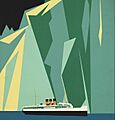Taku Glacier facts for kids
Quick facts for kids Taku Glacier |
|
|---|---|

Taku Glacier in 1992
|
|
| Type | Tidewater glacier |
| Location | City and Borough of Juneau, Alaska, United States |
| Coordinates | 58°35′42″N 134°10′47″W / 58.59500°N 134.17972°W |
| Area | 386 square miles (1000 square kilometers) |
| Length | 58 km (36 miles) |
| Terminus | Taku River |
| Status | Retreating |
Taku Glacier is a huge tidewater glacier found in Taku Inlet, Alaska. It is located just southeast of the city of Juneau. This amazing glacier is known as the deepest and thickest alpine temperate glacier in the world. It is about 4,845 feet (1,477 m) thick and 58 kilometres (36 mi) long. Most of it is inside the Tongass National Forest.
Contents
Discovering Taku Glacier
The Taku Glacier was first named Schultze Glacier in 1883. Later, it was called Foster Glacier in 1890. But the name Taku stuck because that's what the local Tlingit people called it.
Where is Taku Glacier Located?
Taku Glacier is nestled in the Coast Mountains. It starts in the Juneau Icefield. It is the biggest glacier in this icefield. It's also one of the southernmost tidewater glaciers in the Northern Hemisphere. A tidewater glacier is a glacier that flows all the way into the ocean or a large body of water.
How Taku Glacier Moves
The Taku Glacier meets the Taku River at Taku Inlet. This glacier has a cool history of moving forward, or "advancing." Sometimes it moves so much that it blocks the river! When this happens, it creates a big lake behind the ice. Eventually, the ice dam breaks, and the lake water rushes out.
Taku Glacier's Advance
The last time Taku Glacier blocked the river was in 1750. Since 1890, the glacier has moved forward about 7.75 kilometres (4.82 mi). As of June 29, 2012, it was 1.26 kilometres (0.78 mi) away from Taku Point.
Taku Glacier is special because it's the only glacier that is still advancing among the 20 major glaciers in the Juneau Icefield. For a long time, it was moving forward about 17 metres (56 ft) each year.
Why Taku Glacier Advances
Glaciers advance when they have a positive mass balance. This means more snow falls and builds up on the glacier than melts away. Until 1948, Taku Glacier used to lose ice by calving. Calving is when large pieces of ice break off the end of a glacier and fall into the water, forming icebergs. But since 1948, the end of the glacier (called the terminus) has been resting on the ground. This means it stopped losing ice to icebergs.
Because it wasn't losing ice to calving, Taku Glacier kept growing even when other glaciers were shrinking due to warmer temperatures. However, recent studies show that the glacier's mass balance has become negative from 1989 to 2005. This means it's starting to lose more ice than it gains. This might be the first sign that its advance could slow down or even stop.
Taku Glacier's Namesake
The Taku Glacier is so famous that it even has a ferry named after it! The Alaska Marine Highway System ferry M/V Taku was named after this impressive glacier.
Recent Changes
In 2019, scientists reported that Taku Glacier had started to retreat. This means it is now shrinking, like many other glaciers around the world.
Images for kids
-
Ocean liner and Taku Glacier in art for Canadian Pacific
-
View across the Taku Glacier to Taku Towers.





